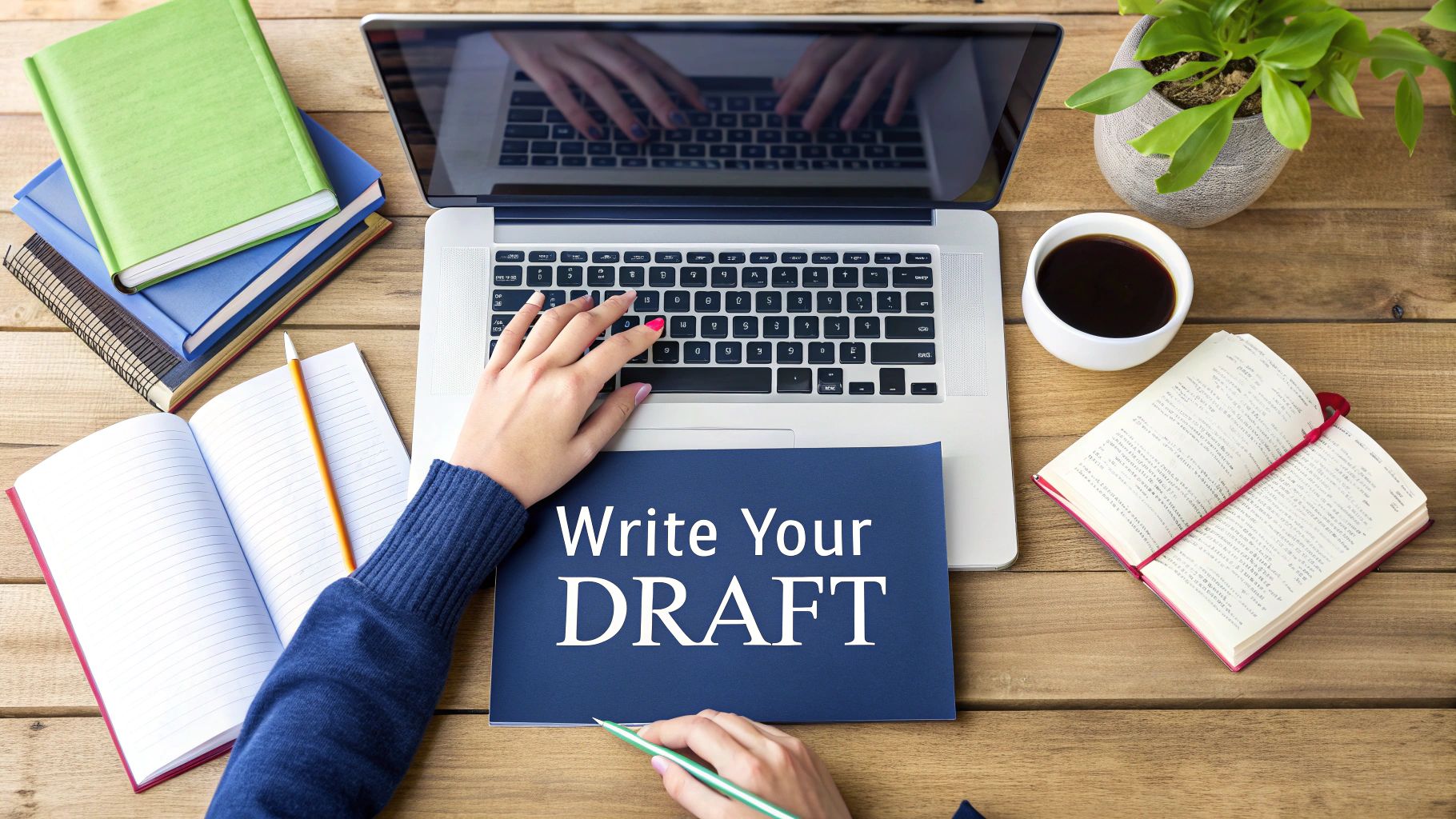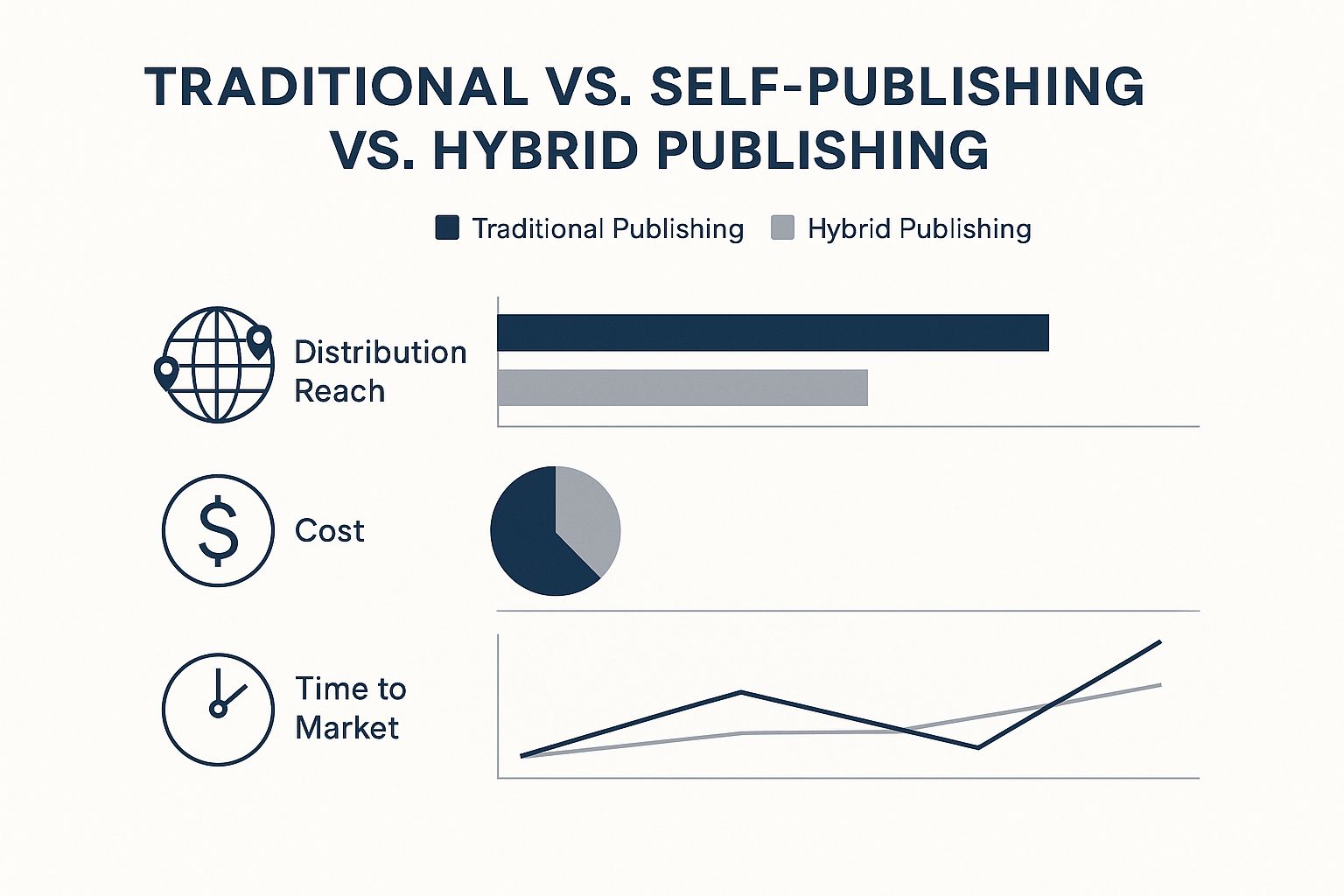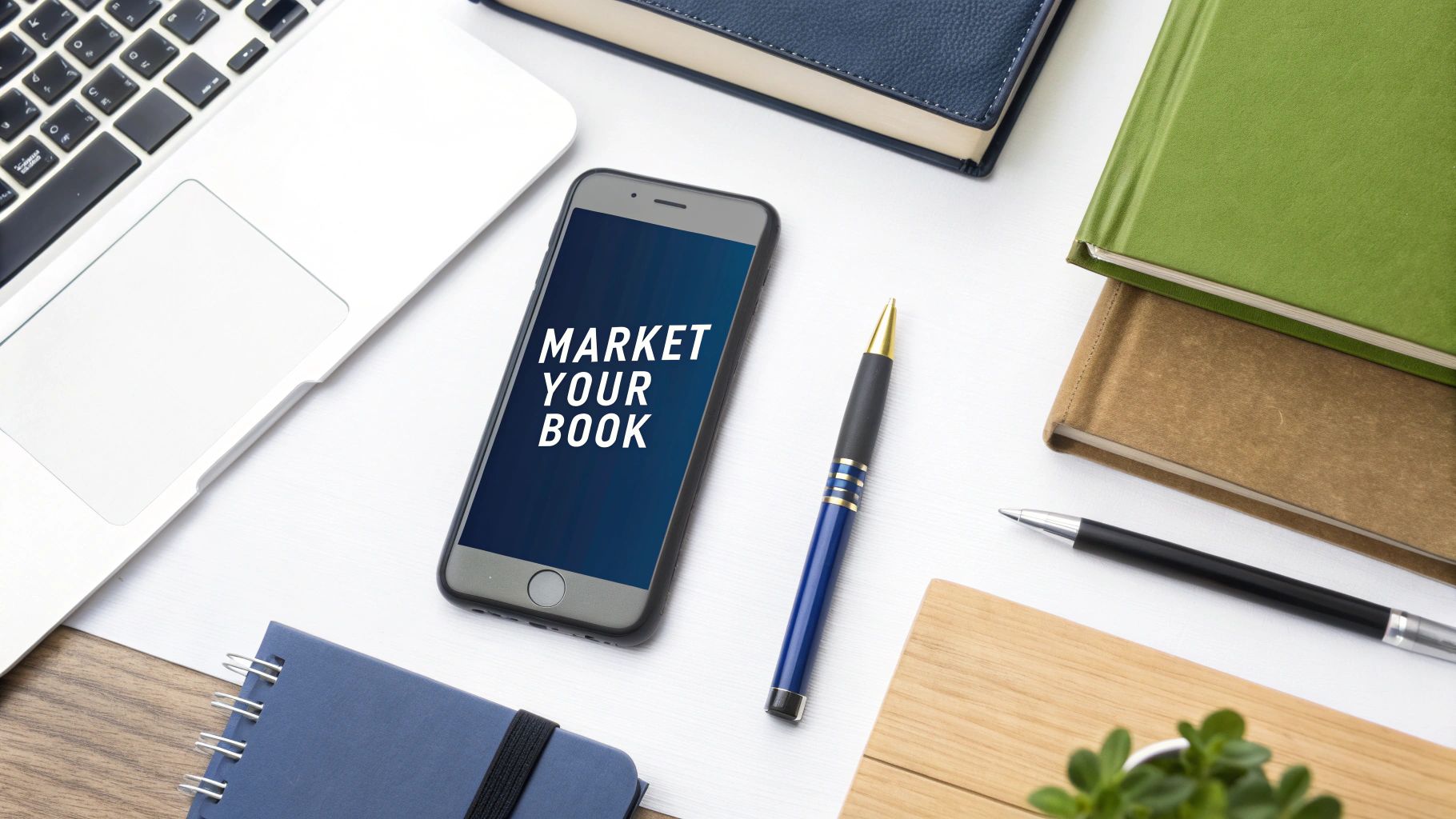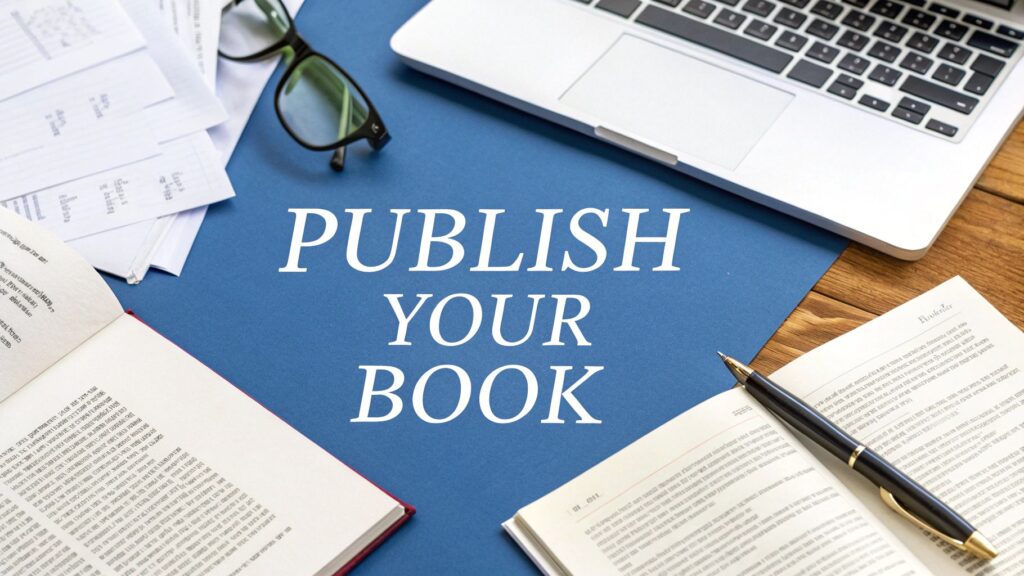Finishing that first draft is a monumental achievement, but in many ways, the real work is just beginning. Publishing a book is all about the journey that takes your raw manuscript and transforms it into a polished, professional product ready for readers. This isn't just about spell-checking; it's about strategically shaping your work to make a real connection.
From First Draft to Polished Manuscript

That moment you type "The End" is exhilarating. But your manuscript at this stage is just the starting point. Think of it as raw clay. The editing process is where you'll sculpt it into something truly special, and it involves much more than just fixing typos. It requires a deep, sometimes painful, look at the very structure of your story.
To turn a personal project into a book that can stand on a shelf next to traditionally published works, you need to understand the different layers of editing. Each one has a distinct job to do in making your book stronger.
The Different Levels of Professional Editing
The first big-picture pass is developmental editing. I like to think of this as the architectural review for your book. A developmental editor isn't looking for misplaced commas; they're looking for major structural flaws. They’ll pinpoint plot holes in your novel, find logical gaps in your non-fiction argument, identify inconsistent characters, and flag pacing issues that could make a reader put your book down for good.
Next up is line editing. This is where the focus narrows to the sentence and paragraph level. It’s all about the craft of writing and sharpening your unique authorial voice. A good line editor will smooth out clunky sentences, flag overused words, fix awkward phrasing, and ensure the tone is consistent. This is what makes your prose sing.
Finally, we get to copyediting and proofreading. This is the final polish, the most detailed level of editing. A copyeditor dives into the nitty-gritty of grammar, spelling, punctuation, and syntax, making sure your manuscript follows a consistent style guide. The proofreader is your last line of defense, giving the text one final pass to catch any sneaky errors that made it through the previous stages.
"A manuscript is not a finished product; it's the beginning of a conversation. Professional editing is your first and most important dialogue, shaping your raw ideas into a story that resonates."
Finding the right editor is one of the most important decisions you'll make. Look for someone with a track record in your specific genre—they'll know the conventions and reader expectations inside and out. Don't hesitate to ask for a sample edit. Many editors will edit a few pages for free or a small fee, which is the perfect way to see if their style clicks with yours.
Assembling Your Team of Beta Readers
Another invaluable step—which you can do before or after professional editing—is getting feedback from actual readers. Beta readers are volunteers who agree to read your manuscript and give you their honest perspective. They are, quite literally, your first audience.
Don’t just send them the manuscript and ask, "So… what do you think?" That's a recipe for vague, unhelpful feedback. Instead, give them specific questions to guide their reading. This turns a simple opinion into actionable advice you can use to improve the book.
Consider asking your beta readers questions like these:
- At what point were you most hooked, and where did your attention start to drift?
- Was there any character you just couldn't connect with? Were their motivations clear?
- Did the ending feel earned and satisfying?
- Were there any parts that were confusing or that you had to read more than once?
This feedback loop is priceless. It gives you a fresh set of eyes on a story you're probably too close to see objectively. For anyone just starting out, a great resource is A Guide to Writing Books for Beginners, which can help you get your draft ready for this critical feedback stage.
When you combine the insights from your beta readers with the expertise of a professional editor, you're giving your book the best possible chance to succeed before it ever moves into design and production.
Traditional or Self-Publishing: Which Path Is Right for You?

So, your manuscript is finally polished and ready. Congratulations! Now you’re standing at a fork in the road, and the choice you make next will define your entire journey as an author. This isn't just about how your book gets printed—it’s about creative control, timelines, royalties, and your long-term career.
The two main routes, traditional and self-publishing, are completely different animals. The right one for you comes down to your personal goals. Do you see your book on a shelf in Barnes & Noble, backed by a big-name publisher? Or do you crave total control, a fast launch, and keeping a much bigger piece of the pie?
Let's dig into what each path really looks like from an author’s perspective.
The Traditional Publishing Route
This is the path most people imagine. You partner with a publishing house, and they put their money behind your book, handling everything from editing and cover design to printing, distribution, and marketing. Sounds great, right? The catch is getting their attention in the first place.
You can't just mail your manuscript to Simon & Schuster. Your first mission is to land a literary agent. Think of an agent as your champion and business partner—they pitch your book to editors and negotiate the nitty-gritty of contracts for you. Finding the right agent is a job in itself.
The key to unlocking that door is the query letter. It’s a one-page sales pitch for both your book and you. A winning query needs to have:
- A killer hook to grab them from the first sentence.
- A short, compelling summary of your book that leaves them wanting more.
- Your author bio, highlighting why you're the person to write this book.
- The basics: genre, word count, and target audience.
If your query hits the mark, an agent will ask for sample chapters or even the whole manuscript. If they fall in love with it and believe they can sell it, they’ll offer you representation. From there, your agent pitches it to publishers. An offer means a book deal, which usually comes with an advance payment against your future royalties.
The traditional path is a marathon, not a sprint. Just finding an agent can take months, sometimes years, of constant querying. Once you sign a deal, it’s typically another 18 to 24 months before your book actually hits the shelves. Patience is non-negotiable here.
The Self-Publishing Revolution
Self-publishing puts you in the CEO chair. You are the publisher. This means you keep all your creative control and every single one of your rights, and you get to market far faster. The entire book industry has been shaken up by this shift.
The global book publishing market has swelled to an estimated $100.14 billion, and a huge part of that growth is fueled by independent authors and digital books. This isn't a niche corner of the industry anymore; it's a massive opportunity.
When you self-publish, you're in charge of the entire process. That means you’re the one hiring editors, cover designers, and interior formatters. You’re also the head of marketing. While that might sound intimidating, platforms like Amazon Kindle Direct Publishing (KDP) and IngramSpark have made the technical side incredibly straightforward.
- Amazon KDP is the undisputed giant. It’s free to publish eBooks and print-on-demand paperbacks, giving you access to Amazon's colossal global audience.
- IngramSpark is the key to wider distribution, getting your book into the catalogs that physical bookstores and libraries use. It's the go-to for authors who want to "go wide" beyond Amazon.
The biggest trade-off? The upfront cost. While you earn much higher royalties—up to 70% on KDP for eBooks compared to a typical 5-15% from a traditional publisher—you have to pay for all the professional services yourself. This is a crucial part of what it takes to become a published author on your own terms.
Ultimately, the choice boils down to what you value most. Traditional publishing offers prestige and a professional team, but it demands immense patience and a loss of control. Self-publishing gives you speed, autonomy, and higher earning potential, but it requires an entrepreneurial mindset and an upfront investment.
Designing a Book That Sells
You’ve poured countless hours into writing and editing, and it’s easy to feel like the hardest work is behind you. But in the crowded world of books, what comes next—the design and production—can make or break your success. It’s a hard truth, but readers absolutely judge a book by its cover. That makes professional design one of the most important investments you’ll make as an author.
A powerful cover isn't just about looking good; it's a piece of visual shorthand. It instantly tells a potential reader everything about your book's genre, tone, and overall quality. Think of it as your most important marketing tool, the one thing that can stop a reader mid-scroll and earn you that crucial click. A professionally designed cover is a non-negotiable step toward publishing a book that actually sells.
Nailing the Cover Design
The single best thing you can do for your cover is hire a professional designer who lives and breathes your genre. They understand the visual cues that readers instinctively look for. A thriller cover has to feel tense, a romance cover needs to hint at passion, and a business book should project confidence and authority.
To get the most out of your collaboration, you’ll need to put together a clear and concise design brief. This isn't about telling the designer exactly what to do; it's about giving them the right ingredients so they can work their magic.
A solid design brief should always include:
- The Basics: Your book’s title, subtitle, and your author name.
- The Vibe: A short summary or blurb that gives the designer a feel for the story or topic.
- The Audience: Who are you writing for? What genre is it? This is crucial for meeting reader expectations.
- The Inspiration: Find 3-5 book covers in your genre that you absolutely love. More importantly, explain why you love them. Is it the font? The color palette? The mood?
This brief acts as a roadmap, ensuring your designer knows where you're headed without you having to backseat drive the entire journey.
Perfecting the Interior Layout
While the cover is what grabs a reader's attention, the interior design—often called typesetting or interior formatting—is what keeps them comfortably immersed in your world. Nothing pulls a reader out of a story faster than a poorly formatted book. It’s jarring and feels amateurish.
Professional typesetting is an art form focused on creating a smooth, almost invisible reading experience. It involves making a lot of small, technical choices that readers might not consciously notice but will definitely feel.
A great interior layout is invisible. Its job is to make the words on the page as easy and enjoyable to read as possible, so the reader forgets they are reading and simply lives in your world.
Key elements here include choosing the right fonts for headings and body text, setting comfortable margins, and ensuring the spacing is consistent from page to page. This is critical for both print and ebooks. While a print layout is static, ebook formatting needs to be “reflowable,” so it can adapt to different screen sizes and user settings. Skimping on this step is a recipe for a messy, unprofessional book on Kindles and other e-readers.
Getting Your Book's Official ID
The final piece of this production puzzle is the International Standard Book Number (ISBN). An ISBN is a unique 13-digit code that acts like your book's fingerprint in the global marketplace. It’s how booksellers, libraries, and distributors all over the world keep track of everything.
Why is it so vital? Without an ISBN, you simply can't sell your book through most major retail channels. Here’s the rundown:
- Each Format Gets a Unique ISBN: Your paperback, hardcover, ebook, and audiobook are all considered different products. That means each one needs its own unique ISBN.
- Where to Get One: In the United States, the official source is Bowker. While platforms like Amazon KDP will offer you a "free" ISBN, be careful. Using their ISBN means they are listed as the publisher, and you can't use that number anywhere else.
- Ownership Gives You Freedom: When you buy your own ISBN, you are the publisher of record. This gives you the ultimate flexibility to work with different printers or distributors, now or down the road.
Securing your ISBNs is the final, official step that turns your manuscript into a legitimate product, ready to be discovered by readers everywhere. It's the last seal of approval before you dive into the world of distribution.
Getting Your Book Into Readers' Hands
With a beautifully designed book and your official ISBN in hand, it's time to tackle the next big piece of the puzzle: getting your work out into the world. This is where you build the bridge connecting your finished manuscript to your future readers. The distribution decisions you make now will directly impact how, where, and when people can buy your book.
At its core, distribution is about choosing the right platforms to make your book available. For most authors going the independent route, this means tapping into the power of online retail giants and print-on-demand services. These companies handle the heavy lifting—printing, sales, order fulfillment, and shipping—freeing you up to focus on what you do best: writing and marketing.
Choosing Your Distribution Channels
When it comes to self-publishing distribution, two names dominate the conversation: Amazon Kindle Direct Publishing (KDP) and IngramSpark. They might seem interchangeable at first glance, but they play distinct strategic roles. In my experience, the most successful authors often use both.
Here’s a quick breakdown:
- Amazon KDP: This is your direct line to the world's largest online marketplace. You simply can't ignore it. KDP makes it incredibly easy to publish ebooks for the Kindle ecosystem, as well as print-on-demand paperbacks and hardcovers sold directly through Amazon’s global storefronts.
- IngramSpark: Think of this as your gateway to the rest of the book world. IngramSpark feeds your book into a massive catalog accessed by thousands of online retailers (like Barnes & Noble), physical bookstores, and libraries. If you want a reader to be able to walk into their local bookshop and order a copy of your book, IngramSpark is the non-negotiable tool to make that happen.
A smart, common strategy is to use KDP for your Amazon print sales and IngramSpark for expanded distribution to every other channel. This approach maximizes your reach without creating messy overlaps. You can find more specifics on the registration process in our detailed guide on how to get an ISBN for my book.
Deciding on your publishing path is a major first step. This table outlines the fundamental differences between the traditional and self-publishing routes to help you weigh your options.
Publishing Path Comparison Traditional vs. Self-Publishing
| Aspect | Traditional Publishing | Self-Publishing |
|---|---|---|
| Upfront Cost | None for the author; publisher invests. | Author pays for editing, design, etc. |
| Control | Author gives up most creative control. | 100% creative and business control. |
| Time to Market | 1-2+ years after signing a contract. | As fast as a few weeks or months. |
| Royalties | Typically 5-15% of net receipts. | Typically 40-70% of the list price. |
| Distribution | Guaranteed access to physical bookstores. | Requires using services like KDP & IngramSpark. |
| Marketing | Publisher handles some, but author effort is key. | 100% author-driven. |
Ultimately, your choice depends on your personal goals—whether you prioritize the prestige and built-in distribution of a traditional deal or the speed, control, and higher royalty rates of self-publishing.
The KDP Select Dilemma: Go Exclusive or Go Wide?
Amazon throws an interesting curveball into the mix with its optional KDP Select program. This is a big strategic choice every author has to make for their ebook.
Enrolling in KDP Select means you agree to sell your ebook exclusively through Amazon for a 90-day period. This term auto-renews, so you have to be proactive if you want to opt out later.
What do you get for this exclusivity? Access to some of Amazon's most powerful promotional tools:
- Kindle Unlimited (KU): Your book becomes part of the KU library. Subscribers can read it for "free," and you get paid for every single page they read. This can be a huge source of income and visibility.
- Promotional Deals: You can run Kindle Countdown Deals (limited-time discounts) or schedule a Free Book Promotion to drive a massive number of downloads, hopefully leading to a surge in reviews and visibility.
The alternative is to "go wide." This means you skip KDP Select and publish your ebook on every platform you can—Apple Books, Kobo, Barnes & Noble, and more, often using an aggregator like Draft2Digital to simplify the process. Going wide builds a more resilient business that isn't dependent on a single retailer, but you forfeit those juicy Amazon-exclusive perks.
My Takeaway: For new authors, enrolling in KDP Select for your first book or two is often a brilliant move. It helps you build momentum and find your readership on the biggest platform out there. Going wide is more of a long-term play, perfect for established authors looking to diversify their income streams.
This infographic breaks down the key stages of bringing a book to market, illustrating how choices in distribution and format fit into the bigger picture.

As the visual shows, self-publishing offers unparalleled speed and lower upfront costs, while the traditional path often provides a broader, more automatic entry into physical stores.
Embrace Multiple Formats for Modern Readers
To truly maximize your book's potential, you need to think beyond a single format. Reader habits are more diverse than ever. Some of us still love the tactile feel of a physical book, while others live on their Kindle or listen to stories during their commute.
Just look at the numbers. In the United States, print book sales recently topped 788.7 million units in a single year. At the same time, audiobooks have posted double-digit growth for nearly a decade. The audience is there, but you have to meet them where they are.
At an absolute minimum, you should publish both a paperback and an ebook. From there, creating an audiobook is a powerful next step. It opens your work up to a completely different segment of the market—people who "read" while driving, exercising, or doing chores. Building a smart, multi-format distribution plan is one of the most important steps to publishing a book successfully today.
Building Your Author Marketing Plan
Hitting "publish" feels like the finish line, but it’s really just the starting gun. Your book is out in the world, but how will anyone find it? A brilliant book is just a file on a server without a smart marketing plan to connect it with readers. This is where you put on your author-entrepreneur hat and build a system to drive sales long after launch week.
A classic rookie mistake is saving all your marketing for after the book is released. The most successful authors I know start building buzz months in advance. You want an audience that’s already excited and waiting on day one. Getting this right is a huge part of publishing a book successfully today.
Laying the Groundwork: Your Author Platform
Think of your author platform as your connection to the reading world. It’s your corner of the internet where you build your brand and gather your community. You don't have to be everywhere at once—just be where your ideal readers already are.
The absolute non-negotiable cornerstone is a professional author website. This is your digital home, the one space you completely own and control. It needs a few key things:
- A sharp homepage with your latest book front and center.
- An "About Me" page that shares your story and helps readers connect with you as a person.
- Dedicated pages for each of your books, complete with buy links to all the major retailers.
- A blog or news section to share updates and give readers a reason to come back.
- A can't-miss signup form for your email list.
Next, you need to be smart about social media. Don't burn yourself out trying to master TikTok, Instagram, Facebook, and X simultaneously. Pick one or two channels where your readers hang out. For example, genres with strong visuals—like fantasy, romance, and cookbooks—crush it on Instagram and TikTok (#BookTok). If you write non-fiction or business books, you’ll likely find a more engaged audience on LinkedIn or X. To get the most out of your time, it's worth learning some effective social media marketing strategies to build a genuine connection.
Building Your Pre-Launch Buzz
A massive launch day doesn't happen by accident; it's engineered. The 2-3 months before your book goes live are all about building a groundswell of excitement. This is your window to get on the radar of both readers and those all-important retail algorithms.
Here's what your launch timeline could look like:
- The Cover Reveal: This is a big moment! Coordinate with book bloggers or use your own channels to unveil your book’s cover, usually about two months before launch day.
- Your ARC Team: Put together a team to read Advance Reader Copies (ARCs). These are your superfans and reviewers who get a free, early digital copy in exchange for posting an honest review the day your book goes live.
- Email List Teasers: Don’t just send a single "my book is coming out" email. Bring your subscribers along for the ride. Share behind-the-scenes stories, character art, or juicy excerpts to keep them hooked.
- The Pre-Order Push: Setting up a pre-order on sites like Amazon is a massive strategic advantage. Every sale you make during the pre-order period counts toward your sales rank on day one, which can trigger a huge visibility boost.
A book launch is a spike, but an author career is a marathon. Your marketing plan should be designed to fuel both—creating initial excitement and then settling into a sustainable rhythm of promotion.
Post-Launch Strategies for Sustained Sales
Once your book is live, your job shifts from building buzz to driving consistent sales and reviews. The first 30 days are critical, but your plan should extend far beyond that initial month.
Paid advertising, especially Amazon Ads, is a major driver of visibility. It can feel intimidating at first, but you can start small. Target ads based on authors who write books like yours or on keywords readers use to find books in your genre. Even a budget of $5-$10 a day can give you incredibly valuable data.
Another fantastic tactic is working with book bloggers and influencers in your niche. These creators have built-in audiences who trust their recommendations. A single positive review from a well-regarded blogger can send a wave of new readers your way.
Finally, never stop growing your email list. This is your single most valuable marketing tool because it's a direct line to your biggest fans. Offer a "reader magnet"—a free short story, a deleted scene, or a useful checklist—to convince people to subscribe. It's a long-term play that pays off every single time you release a new book.
For authors who feel overwhelmed by all these moving parts, using professional marketing and book distribution services can be a lifesaver. It frees you from the logistical headaches so you can get back to what you do best: writing the next book.
Common Questions About Publishing a Book

If you're stepping into the publishing world for the first time, your head is probably swimming with questions. That's completely normal. I've heard them all over the years, and most authors are wrestling with the same practical details.
Let’s clear up some of the most common sticking points. Once you have these answers, you can move forward with confidence and focus on what really matters: getting your book into the hands of readers.
How Much Does It Cost to Publish a Book?
This is usually the first question on every author's mind, and the honest answer is: it really depends on the route you take and the quality you're aiming for.
When you self-publish, you're in the driver's seat of the budget. It's technically possible to publish for almost nothing if you do everything yourself—design the cover with a free tool, self-edit, and format it on your own. But let's be real: that approach rarely produces a book that can compete in today's market.
A realistic budget for a professionally self-published book typically lands somewhere between $1,500 and $5,000. This investment covers the essentials:
- Professional Editing: This is non-negotiable and your most critical expense. It includes everything from big-picture developmental editing to a final, eagle-eyed proofread.
- Cover Design: Your cover is your #1 marketing tool. A professional design can range from a few hundred dollars for a quality pre-made cover to over a thousand for a custom illustration.
- Interior Formatting: Making sure your book's interior is clean, readable, and professional in both print and ebook formats is a must.
- Marketing & Promotion: This could be anything from running Amazon ads and building an email list to hiring a publicist.
With traditional publishing, on the other hand, you pay nothing upfront. The publisher invests in your book, covering all the costs of editing, design, printing, and distribution.
How Long Does the Publishing Process Take?
The timeline is another major difference between traditional and self-publishing. This is where you really see the trade-off between speed and gatekeepers.
The traditional path is a marathon, not a sprint. From the moment you sign a contract, it can easily take 18 to 24 months before your book actually hits the shelves. Self-publishing lets you set your own pace, and you can take a finished manuscript to a live, published book in just a few weeks.
Why the long wait in traditional publishing? It's all about their internal pipeline—long editorial schedules, seasonal sales catalogs, printing lead times, and coordinating with distributors. When you self-publish, you become the project manager, so the only thing slowing you down is how quickly you can line up your editor, designer, and other freelancers.
Can I Edit My Book After It Is Published?
Yes, you can! This is one of the most powerful advantages of modern self-publishing. Found a sneaky typo after hitting "publish"? Want to update a chapter with new information a year later? No problem.
Platforms like Amazon KDP make it incredibly simple. You just upload the revised manuscript or an updated cover file. The new version will typically replace the old one on the live product page within 24 to 72 hours.
This flexibility is fantastic because it means your book can be a living document. And since most self-published print books use print-on-demand technology, there’s no outdated inventory to worry about. Every new order will be printed with your latest, most polished files.
Ready to take the guesswork out of publishing and ensure your book meets the highest professional standards? BarkerBooks offers comprehensive, end-to-end services, from expert editing and stunning design to global distribution and targeted marketing. Let our experienced team help you bring your vision to life. Learn more and start your publishing journey today.
